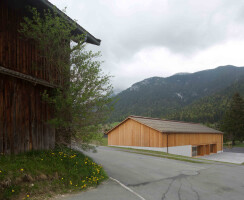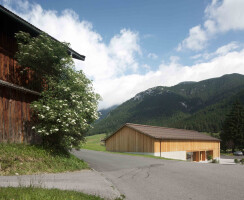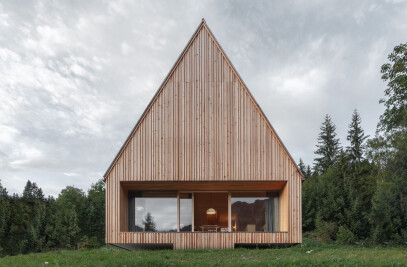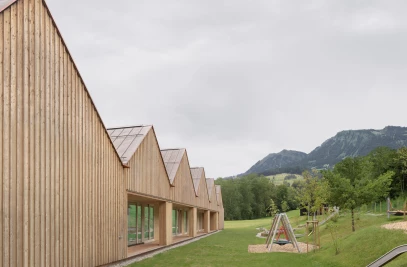The ensemble of the Village House, the existing community center and church - what may seem unspectacular in advance - should prove a convincing spatial dialogue experiment how a previously not existing village center can function in the future and contextual relations can be sustainable. The aim was to reactivate a traditional construction, without stumbling into the depths of a superficial, sentimental architecture.
The subtlety of the intervention may be revealed only at second glance.
Territorial context and setting in the settlement structure
The municipality Steinberg am Rofan is dominated by few small scale public buildings, small houses and wide open spaces. The project tries sensitively to respond to this complex situation and embed numerous contextual references to the environment in the existing village structure.
Thus the new community center is presented by means of a very precise spatial village setting as a link between private and public space and interweaves calmly and naturally in a local grammar.
Through the setting, a new village square is generated, with a spatial quality that meets the requirement of various usages. The resulting gate effect generates an exciting entrée and ensures the visitor a pleasant "surprise" at the end of the valley.
By the elongated shape of the building and its parallel placement to the road the outside is divided into two areas. At the entrance a forecourt, oriented to south-east and laid out with stones, with high amenity value can also be used by the café in summer. Between school, the old and the new community center, the actual village square stretches and is used for larger events.
Compactness | Interior and exterior spatial quality Like a traditional farmhouse (living quarter / threshing floor/ stable) the new community center is zoned into three areas. The multi-purpose hall and farmers’ café are accessed via a central foyer, which can divide functions or, in case of a major event, merge space. The front part of the building is organized compact and two-story and opens on the ground floor generously to the village square and the church, while the multi-purpose hall, slightly recessed in the slope, has skylights and a greater degree of privacy.
The internal spatial sequences are designed both exciting and varied with a very high quality of stay, characterized by diverse insights and outlooks. The result is a very simple and reduced space continuum, which has both economic and creative strengths.
Construction and materials | The Best is so close
The consistent use of the building material larch ought to be understood as a vote for the continuation of a local tradition. Static simplicity and a very high degree of prefabrication of the external wall and ceiling elements guaranteed a short construction period. Untreated domestic wood has been consistently used as building material for all parts of the interior fittings and for all facades. The sensory quality of the untreated wood is complemented by measurable criteria, such as pollution-free air and an excellent life cycle assessment. The wood used was provided exclusively and in an exemplary manner from larch forests of the Rofan Mountains. Through the introduction of own resources and also of their own work in terms of a proper value creation (sawyers from the village, drying, processing) a portable guiding principle for the project existed at a very early stage before the beginning of all joint efforts.

































